Adding Mouse Guards to the Hives
The temperatures in our region are dropping into the lower 30's at night this week, and I've been meaning to get the mouse guards in place. What a better time then now?!
When the weather turns cold and the bees are clustered in the hive and unable to actively guard the front entrance, mice take the opportunity and sneak into the hive and enjoy a warm place to live during the winter. They will often chew through frames of comb, leaving a lot of destruction.
There are many types of commercial mouse guards available, or you can build your own. For my hives, I'm trying two different "home made" mouse guards.
The first is a piece of angle iron, the kind used to attach garage door motors to the ceiling of a garage. The holes are the perfect size, and the material is not made of wood, which the mice could easily chew through. The metal has been bent such that the holes are right at the bend. This way, the bees don't have to step "up into" the holes to pass through them. We also drilled two holes in either side to allow two screws to securely anchor the guard to the landing board.
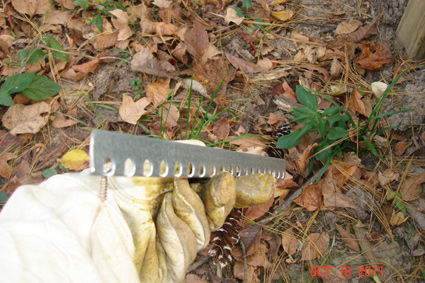
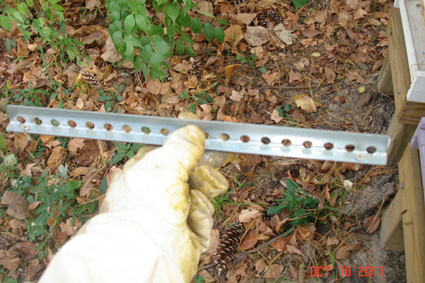
The blue and purple hive received the angle iron guard, as their population is still so large, I felt they could use the extra entrance holes for now. I could always cover the holes with regular duct tape or metal duct tape.
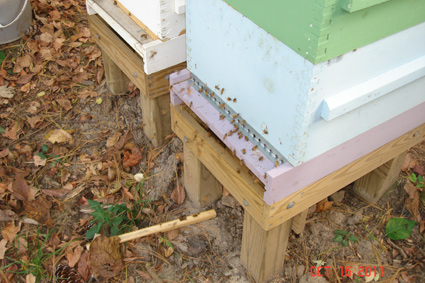
The white hive, which desperately needs their reduced entrance still, is getting a different guard. In this case, the angle iron has been cut so there is no more 90 degree bend, only a straight piece of metal with holes.
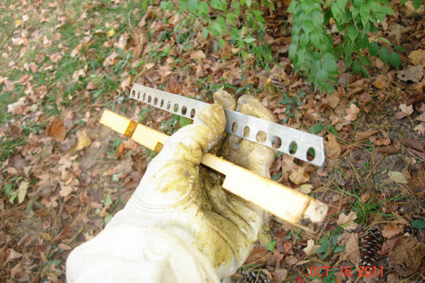
In this case, I'm going to screw the metal guard directly onto the front of the existing wooden reducer. The reducer will block all the openings except one or two, while still providing a metal exterior that a mouse can't chew through.

You can see that only one opening, about 4 inches from the left, is actually open yet the whole wooden reducer is now protected from mice chewing on it.
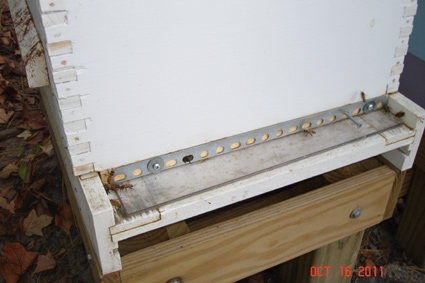
It was fun to watch the bees land and trying to decide if this was indeed their hive or not. They recognized the white hive bodies, but not he new all metal guard that greeted them.
They walked back and forth trying a few of the holes, only to realize they were blocked by the wooden reducer. Eventually a few of them figured out where the entrance was, and they all made it.
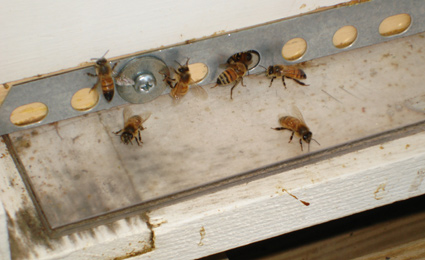
Here's a question to other beekeepers: Do you bother to use mouse guards? Have you ever had a mouse in the hive over winter?
When the weather turns cold and the bees are clustered in the hive and unable to actively guard the front entrance, mice take the opportunity and sneak into the hive and enjoy a warm place to live during the winter. They will often chew through frames of comb, leaving a lot of destruction.
There are many types of commercial mouse guards available, or you can build your own. For my hives, I'm trying two different "home made" mouse guards.
The first is a piece of angle iron, the kind used to attach garage door motors to the ceiling of a garage. The holes are the perfect size, and the material is not made of wood, which the mice could easily chew through. The metal has been bent such that the holes are right at the bend. This way, the bees don't have to step "up into" the holes to pass through them. We also drilled two holes in either side to allow two screws to securely anchor the guard to the landing board.


The blue and purple hive received the angle iron guard, as their population is still so large, I felt they could use the extra entrance holes for now. I could always cover the holes with regular duct tape or metal duct tape.

The white hive, which desperately needs their reduced entrance still, is getting a different guard. In this case, the angle iron has been cut so there is no more 90 degree bend, only a straight piece of metal with holes.

In this case, I'm going to screw the metal guard directly onto the front of the existing wooden reducer. The reducer will block all the openings except one or two, while still providing a metal exterior that a mouse can't chew through.

You can see that only one opening, about 4 inches from the left, is actually open yet the whole wooden reducer is now protected from mice chewing on it.

It was fun to watch the bees land and trying to decide if this was indeed their hive or not. They recognized the white hive bodies, but not he new all metal guard that greeted them.
They walked back and forth trying a few of the holes, only to realize they were blocked by the wooden reducer. Eventually a few of them figured out where the entrance was, and they all made it.

Here's a question to other beekeepers: Do you bother to use mouse guards? Have you ever had a mouse in the hive over winter?
Comments For This Post: (1) | Post Your Comments! Hide The Comment Form